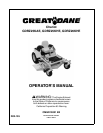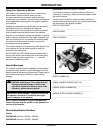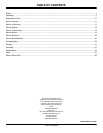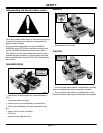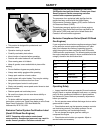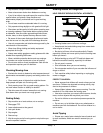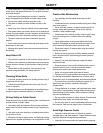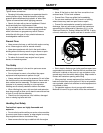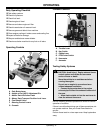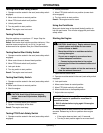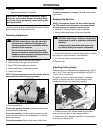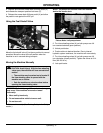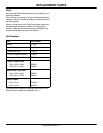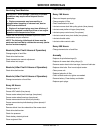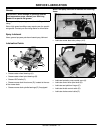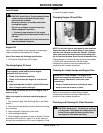
Safety - 4
SAFETY
• Drive across a hill - not up and down. If necessary, turn
slowly and in the downhill direction. Do not shift to neutral
and coast downhill.
• Avoid starting and stopping on a slope. If machine
stops, disengage mower blades and back down slowly.
• Do not drive where machine could slip or tip.
• Stay alert for holes and other hidden hazards in the
terrain.
• Keep away from drop-offs, ditches, and embankments.
• Slow down before you make a sharp turn or operate on
a slope. On gear models, choose a low gear so that shifting
and stopping will not be necessary while on the slope.
• Transport machine with decks lowered to improve
stability.
• Drive machine very slowly and avoid quick stops when
attachment is removed.
• Mowing when grass is wet can cause reduced traction
and sliding.
Keep Riders Off
• Only allow the operator on the machine. Keep riders off.
• Riders on the machine or attachment may be struck by
foreign objects or thrown off the machine causing serious
injury.
• Riders obstruct the operator’s view resulting in the
machine being operated in an unsafe manner.
Checking Wheel Bolts
• A serious accident could occur causing serious injury if
wheel bolts are not tight.
• Check wheel bolt tightness often during the first 100
hours of operation.
• Wheel hardware must be tightened to specified torque
using the proper procedure anytime it is loosened.
Driving Safely on Public Roads
Avoid personal injury or death resulting from a collision with
another vehicle on public roads:
• Use safety lights and devices. Slow moving machines
when driven on public roads are hard to see, especially at
night.
• Use extra care when loading or unloading the machine
into a trailer or truck.
• Whenever driving on public roads, use flashing warning
lights and turn signals according to local regulations. Extra
flashing warning lights may need to be installed.
Practice Safe Maintenance
• Only qualified, trained adults should service this
machine.
• Understand service procedure before doing work. Keep
area clean and dry.
• Never lubricate, service, or adjust machine while it is
moving. Keep safety devices in place and in working
condition. Keep hardware tight.
• Keep hands, feet, clothing, jewelry, and long hair away
from any moving parts, to prevent them from getting
caught.
• Lower attachments to the ground before servicing
machine. Disengage all power and stop the engine. Lock
park brake and remove the key. Let machine cool.
• Disconnect battery or remove spark plug wire before
making any repairs.
• Before servicing machine, carefully release pressure
from components with stored energy such as hydraulic
components.
• Keep all nuts and bolts tightened, especially blade
attachment bolts.
• Securely support any machine elements that must be
raised for service work. Lock service latches before
working on machine with raised attachments.
• Never run engine unless park brake is locked.
• Keep all parts in good condition and properly installed.
Fix damage immediately. Replace worn or broken parts.
Replace all worn or damaged safety and instruction decals.
• To prevent fires, remove any buildup of grease, oil, or
debris from the machine, especially the engine
compartment.
• Charge batteries in an open, well-ventilated area, away
from sparks. Unplug battery charger before connecting or
disconnecting from the battery. Wear protective clothing
and use insulated tools.
• Do not modify machine or safety devices. Unauthorized
modifications may impair its function and safety.
• Do not wear radio or music headphones while servicing
the machine. Safe service requires your full attention.
Avoid High Pressure Fluids
• Hydraulic hoses and lines can fail due to physical
damage, kinks, age, and exposure. Check hoses and lines
regularly. Replace damaged hoses and lines.
• Hydraulic fluid connections can loosen due to physical



